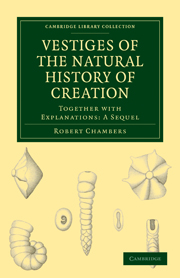Book contents
- Frontmatter
- Contents
- THE BODIES OF SPACE—THEIR ARRANGEMENTS AND FORMATION
- CONSTITUENT MATERIALS OF THE EARTH, AND OF THE OTHER BODIES OF SPACE
- THE EARTH FORMED—ERA OF THE PRIMARY ROCKS
- COMMENCEMENT OF ORGANIC LIFE—SEA PLANTS, CORALS, ETC
- ERA OF THE OLD RED SANDSTONE—FISHES ABUNDANT
- SECONDARY ROCKS—ERA OF THE CARBONIFEROUS FORMATION—COMMENCEMENT OF LAND PLANTS
- ERA OF THE NEW RED SANDSTONE—TERRESTRIAL ZOOLOGY COMMENCES WITH REPTILES—FIRST TRACES OF BIRDS
- ERA OF THE OOLITE—COMMENCEMENT OF MAMMALIA
- ERA OF THE CRETACEOUS FORMATION
- ERA OF THE TERTIARY FORMATION — MAMMALIA ABUNDANT
- ERA OF THE SUPERFICIAL FORMATIONS—COMMENCEMENT OF PRESENT SPECIES
- GENERAL CONSIDERATIONS RESPECTING THE ORIGIN OF THE ANIMATED TRIBES
- PARTICULAR CONSIDERATIONS RESPECTING THE ORIGIN OF THE ANIMATED TRIBES
- HYPOTHESIS OF THE DEVELOPMENT OF THE VEGETABLE AND ANIMAL KINGDOMS
- AFFINITIES AND GEOGRAPHICAL DISTRIBUTION OF ORGANISMS
- EARLY HISTORY OF MANKIND
- MENTAL CONSTITUTION OF ANIMALS
- PURPOSE AND GENERAL CONDITION OF THE ANIMATED CREATION
- NOTE CONCLUSORY
- APPENDIX
COMMENCEMENT OF ORGANIC LIFE—SEA PLANTS, CORALS, ETC
Published online by Cambridge University Press: 05 August 2011
- Frontmatter
- Contents
- THE BODIES OF SPACE—THEIR ARRANGEMENTS AND FORMATION
- CONSTITUENT MATERIALS OF THE EARTH, AND OF THE OTHER BODIES OF SPACE
- THE EARTH FORMED—ERA OF THE PRIMARY ROCKS
- COMMENCEMENT OF ORGANIC LIFE—SEA PLANTS, CORALS, ETC
- ERA OF THE OLD RED SANDSTONE—FISHES ABUNDANT
- SECONDARY ROCKS—ERA OF THE CARBONIFEROUS FORMATION—COMMENCEMENT OF LAND PLANTS
- ERA OF THE NEW RED SANDSTONE—TERRESTRIAL ZOOLOGY COMMENCES WITH REPTILES—FIRST TRACES OF BIRDS
- ERA OF THE OOLITE—COMMENCEMENT OF MAMMALIA
- ERA OF THE CRETACEOUS FORMATION
- ERA OF THE TERTIARY FORMATION — MAMMALIA ABUNDANT
- ERA OF THE SUPERFICIAL FORMATIONS—COMMENCEMENT OF PRESENT SPECIES
- GENERAL CONSIDERATIONS RESPECTING THE ORIGIN OF THE ANIMATED TRIBES
- PARTICULAR CONSIDERATIONS RESPECTING THE ORIGIN OF THE ANIMATED TRIBES
- HYPOTHESIS OF THE DEVELOPMENT OF THE VEGETABLE AND ANIMAL KINGDOMS
- AFFINITIES AND GEOGRAPHICAL DISTRIBUTION OF ORGANISMS
- EARLY HISTORY OF MANKIND
- MENTAL CONSTITUTION OF ANIMALS
- PURPOSE AND GENERAL CONDITION OF THE ANIMATED CREATION
- NOTE CONCLUSORY
- APPENDIX
Summary
The group of rocks placed above the Primary, bears the general name of Silurian, from their being presented on the surface in a portion of Western England formerly occupied by a people whom the Roman historians call Silures. It is also developed very extensively in Northern Europe, and in North America. The group is divided by geologists into two distinct formations, the Lower and Upper.
Hitherto nothing has been said of the fossils which constitute so important a part of geological science. It is now to be observed that, from an early portion of the rock series to its close, the mineral masses are found to enclose remains of the organic beings (plants and animals) which flourished upon earth during the time when those were forming; and these organisms, or such parts of them as were of sufficient solidity, have been in many instances preserved with the utmost fidelity, although for the most part converted into the substance of the enclosing mineral. The rocks may be said thus to form an organic history of our globe, from perhaps near the commencement of life upon its surface to the present time. This is a piece of knowledge entirely new to man, and it may be safely said that he has never made a merely intellectual acquisition of a more interesting or remarkable nature. I am to trace this history as well as existing materials will permit.
- Type
- Chapter
- Information
- Vestiges of the Natural History of CreationTogether with Explanations: A Sequel, pp. 55 - 67Publisher: Cambridge University PressPrint publication year: 2009First published in: 1844



